IBM PCI Eden400, CFC2, PCI-6871, LCD-LVDS-LAN User Manual

PCI-6871
PCI Eden400 Half-sized SBC
with SODIMM/VGA
LCD/LVDS/LAN and CFC2
Users’ Manual
Copyright
This document is copyrighted, © 2002. All rights are reserved. The original manufacturer reserves the right to make improvements to the products described in this manual at any time without notice.
No part of this manual may be reproduced, copied, translated or transmitted in any form or by any means without the prior written permission of the original manufacturer. Information provided in this manual is intended to be accurate and reliable. However, the original manufacturer assumes no responsibility for its use, nor for any infringements upon the rights of third parties that may result from such use.
Acknowledgements
Award is a trademark of Award Software International, Inc. VIA is a trademark of VIA Technologies, Inc.
IBM, PC/AT, PS/2 and VGA are trademarks of International Business Machines Corporation.
Intel and Pentium are trademarks of Intel Corporation.
Microsoft Windows® is a registered trademark of Microsoft Corp. RTL is a trademark of Realtek Semi-Conductor Co., Ltd.
ESS is a trademark of ESS Technology, Inc.
UMC is a trademark of United Microelectronics Corporation. SMI is a trademark of Silicon Motion, Inc.
Creative is a trademark of Creative Technology LTD.
All other product names or trademarks are properties of their respective owners.
For more information on this and other EMAC products, please visit our website at: http://www.emacinc.com
For technical support and service, please visit our support website at: http://www.emacinc.com/support/
This manual is for the PCI-6871.
Part No. 2006687110 1st Edition, Dec, 2002
PCI-6871 User’s Manual |
ii |

Packing List
Before you begin installing your card, please make sure that the following materials have been shipped:
•1 ea. PCI-6871 all-in-one single board computer
•1 ea. startup manual
•CD-ROM or disks for utility, drivers, and manual (in PDF format)
•1 ea. power cable p/n: 1703080101
•1 ea. PS/2 KB/M cable p/n: 1700060202
•1 ea. Printer cable p/n:1700260250
•1 ea. FDD cable p/n:1701340603
•1 ea. EIDE cable p/n:1701400452
If any of these items are missing or damaged, contact your distributor or sales representative immediately.
Model No. List |
Description |
PPCI-6871F-J0A1 PCI Eden400 Half-sized SBC with SODIMM/VGA LCD/LVDS/LAN and CFC2
Additional Information and Assistance
1.Visit the manufacturer's web site at www.emacinc.com where you can find the latest information about the product.
2.Contact your distributor, sales representative, or customer
service center for technical support if you need additional assistance. Please have the following information ready before you call:
•Product name and serial number
•Description of your peripheral attachments
•Description of your software (operating system, version, application software, etc.)
•A complete description of the problem
•The exact wording of any error messages
iii
PCI-6871 User’s Manual |
iv |
Table of Contents
Contents
Chapter 1 |
General Information ........................................ |
1 |
|
1.1 |
Introduction ....................................................................... |
2 |
|
1.2 |
Features ............................................................................. |
3 |
|
1.3 |
Specifications .................................................................... |
3 |
|
|
1.3.1 |
Standard SBC Functions................................................. |
3 |
|
1.3.2 |
VGA/LCD/LVDS Interface............................................ |
4 |
|
1.3.3 LVDS: Supports 2 Channel LVDS interface................ |
4 |
|
|
1.3.4 PCI bus Ethernet interface .............................................. |
4 |
|
|
1.3.5 |
Mechanical and Environmental ...................................... |
4 |
1.4 |
Board layout: dimensions.................................................. |
5 |
|
Chapter 2 |
Installation ........................................................ |
7 |
|
2.1 |
Jumpers.............................................................................. |
8 |
|
2.2 |
Connectors......................................................................... |
8 |
|
2.3 |
Locating jumpers............................................................. |
10 |
|
2.4 |
Locating Connectors ....................................................... |
11 |
|
2.5 |
Setting Jumpers ............................................................... |
12 |
|
2.6 |
Clear CMOS (JP1) .......................................................... |
13 |
|
2.7 |
Installing system memory (SODIMMs).......................... |
14 |
|
|
2.7.1 |
Installing SODIMMs .................................................... |
14 |
2.8 |
IDE, CDROM hard drive connector (CN1, CN7)........... |
15 |
|
|
2.8.1 Connecting the hard drive............................................. |
16 |
|
2.9 |
Solid State Disk............................................................... |
16 |
|
|
2.9.1 |
CompactFlash (CN28) .................................................. |
16 |
2.10 |
Floppy drive connector (CN6) ........................................ |
16 |
|
|
2.10.1 Connecting the floppy drive ......................................... |
17 |
|
2.11 |
Parallel port connector (CN2) ......................................... |
17 |
|
2.12 |
Keyboard and PS/2 mouse connector (CN25) ................ |
17 |
|
2.13 |
Power & HDD LED, Reset (CN13, CN8) ...................... |
18 |
|
|
2.13.1 Power & HDD LED (CN13) ........................................ |
18 |
|
|
2.13.2 |
Reset switch (CN8)....................................................... |
18 |
2.14 |
Power connectors (CN11, FAN1) ................................... |
18 |
|
|
2.14.1 |
Main power connector, +5 V, +12 V (CN11).............. |
18 |
|
2.14.2 CPU Fan power supply connector (FAN1)................... |
18 |
|
2.15 |
ATX power control connector (CN3, CN5).................... |
19 |
|
|
2.15.1 ATX feature (CN3) and soft power switch (CN5) ....... |
19 |
|
2.16 |
IR connector (CN9)......................................................... |
20 |
|
2.17 |
Audio interfaces (CN10) ................................................. |
20 |
|
2.18 |
COM port connector (CN19, CN20)............................... |
20 |
|
|
2.18.1 COM2 RS-232/422/485 setting (JP3)........................... |
20 |
|
2.19 |
VGA/LCD/LVDS interface connections ........................ |
20 |
|
|
2.19.1 CRT display connector (CN12) .................................... |
21 |
|
v
|
|
2.19.2 |
Flat panel display connector (CN18) ............................ |
21 |
|
|
2.19.3 |
Extension flat panel connector (CN17) ........................ |
21 |
|
|
2.19.4 |
LVDS LCD panel connector (CN21) ........................... |
21 |
|
|
2.19.5 |
Panel type selection (S1)............................................... |
22 |
|
2.20 |
Ethernet configuration..................................................... |
22 |
|
|
|
2.20.1 |
100Base-T connector (CN15)....................................... |
23 |
|
|
2.20.2 |
Network boot ................................................................ |
23 |
|
|
2.20.3 |
LAN controller power select (JP2) ............................... |
23 |
|
2.21 |
Watchdog timer configuration ........................................ |
23 |
|
|
|
2.21.1 |
Watchdog timer action (JP4) ........................................ |
23 |
|
2.22 |
USB connectors (CN4, CN23) ........................................ |
24 |
|
Chapter |
3 |
Software Configuration ................................. |
25 |
|
|
3.1 |
Introduction ..................................................................... |
26 |
|
|
3.2 |
Connections to Three Standard LCDs............................. |
27 |
|
|
|
3.2.1 |
Connections to (640 x 480 TFT color LCD) ............... |
27 |
|
|
3.2.2 |
Connections to (1024 x 768 TFT color LCD) ............. |
28 |
|
|
3.2.3 |
Connections to (800 x 600 TFT color LCD) ............... |
29 |
|
3.3 |
Ethernet software configuration ...................................... |
30 |
|
Chapter |
4 |
Award BIOS Setup......................................... |
33 |
|
|
4.1 |
System test and initialization........................................... |
34 |
|
|
|
4.1.1 |
System configuration verification................................. |
34 |
|
4.2 |
Award BIOS setup .......................................................... |
35 |
|
|
|
4.2.1 |
Entering setup .............................................................. |
35 |
|
|
4.2.2 |
Standard CMOS Features setup.................................... |
36 |
|
|
4.2.3 |
Advanced BIOS Features setup .................................... |
37 |
|
|
4.2.4 |
Advanced Chipset Features setup ................................. |
38 |
|
|
4.2.5 |
Integrated Peripherals ................................................... |
39 |
|
|
4.2.6 |
Power Management Setup ............................................ |
39 |
|
|
4.2.7 |
PnP/PCI Configurations................................................ |
40 |
|
|
4.2.8 |
PC Health Status ........................................................... |
40 |
|
|
4.2.9 |
Frequency/Voltage Control........................................... |
41 |
|
|
4.2.10 |
Load Optimized Defaults.............................................. |
42 |
|
|
4.2.11 |
Set Password................................................................. |
42 |
|
|
4.2.12 |
Save & Exit Setup......................................................... |
43 |
|
|
4.2.13 |
Exit Without Saving...................................................... |
44 |
Chapter |
5 |
PCI SVGA Setup ............................................ |
45 |
|
|
5.1 |
Introduction ..................................................................... |
46 |
|
|
|
5.1.1 |
Chipset .......................................................................... |
46 |
|
|
5.1.2 |
Display memory............................................................ |
46 |
|
|
5.1.3 |
Display types................................................................. |
46 |
|
|
5.1.4 |
Dual/Simultaneous Display .......................................... |
47 |
|
5.2 |
Installation of the SVGA Driver ..................................... |
48 |
|
vi
Table of Contents |
|
|
|
|
|
|
5.2.1 Installation for Windows 95 ......................................... |
48 |
|
|
|
5.2.2 Installation for Windows 98/Me ................................... |
52 |
|
|
|
5.2.3 Installation for Windows NT ........................................ |
57 |
|
|
|
5.2.4 Installation for Windows 2000 ..................................... |
62 |
|
|
|
5.2.5 Installation for Windows XP ........................................ |
67 |
|
|
5.3 |
Further Information......................................................... |
73 |
|
Chapter |
6 |
Audio Setup..................................................... |
75 |
|
|
6.1 |
Introduction ..................................................................... |
76 |
|
|
6.2 |
DOS utilities.................................................................... |
76 |
|
|
|
6.2.1 VIA Sound Blaster Pro compatible set up program ..... |
76 |
|
|
|
6.2.2 VIA Sound Blaster Installation..................................... |
76 |
|
|
6.3 |
Driver installation............................................................ |
77 |
|
|
|
6.3.1 |
Before you begin........................................................... |
77 |
|
|
6.3.2 |
Windows 95/98 drivers................................................. |
77 |
|
|
6.3.3 |
Windows NT drivers..................................................... |
85 |
|
|
6.3.4 |
Windows 2000 Drivers ................................................. |
88 |
Chapter |
7 |
PCI Bus Ethernet Interface........................... |
93 |
|
|
7.1 |
Introduction ..................................................................... |
94 |
|
|
7.2 |
Installation of Ethernet driver ......................................... |
94 |
|
|
|
7.2.1 Installation for MS-DOS and Windows 3.1.................. |
94 |
|
|
|
7.2.2 Installation for Windows 98 ......................................... |
95 |
|
|
|
7.2.3 Installation for Windows 2000 ..................................... |
98 |
|
|
|
7.2.4 Installation for Windows NT ...................................... |
103 |
|
|
7.3 |
Further information ....................................................... |
109 |
|
Appendix A |
Programming the Watchdog Timer ........... |
111 |
||
|
A.1 |
Supported Input Timing Modes .................................... |
112 |
|
Appendix |
B |
Installing PC/104 Modules .......................... |
115 |
|
Appendix C |
Pin Assignments ........................................... |
121 |
||
|
C.1 |
CPU Fan Power Connector (FAN 1)............................. |
122 |
|
|
C.2 |
Ethernet 10/100Base-T Connector (CN15)................... |
122 |
|
|
C.3 |
Audio Connector (CN10) .............................................. |
123 |
|
|
C.4 |
Main Power Connector (CN11) .................................... |
124 |
|
|
C.5 |
Keyboard and PS/2 Mouse Connector (CN25) ............. |
125 |
|
|
C.6 |
Floppy Disk Drive Connector (CN6) ............................ |
126 |
|
|
C.7 |
IDE Hard Drive Connector (CN1, CN7) ...................... |
127 |
|
|
C.8 |
Parallel Port Connector (CN2) ...................................... |
128 |
|
|
C.9 |
HDD, PWR LED CON & WDT output (CN13)........... |
129 |
|
C.10 |
Reset Button Connector (CN8) ..................................... |
129 |
||
C.11 |
USB Connector (CN20, CN28)..................................... |
130 |
||
C.12 |
LCD Inverter Backlight Connector (CN27).................. |
130 |
||
C.13 |
IR Connector (CN9) ...................................................... |
131 |
||
vii
C.14 |
CRT Display Connector (CN12)................................... |
131 |
C.15 |
Flat Panel Connector (CN18)........................................ |
132 |
C.16 |
Extended Flat Panel Display Connector (CN17) .......... |
133 |
C.17 |
LCD Signal Mapping .................................................... |
134 |
C.18 |
LVDS Connector (CN21).............................................. |
135 |
C.19 |
COM Port Connector (CN19, CN20)............................ |
136 |
C.20 |
CompactFlash Card Connector (CN28) ........................ |
137 |
C.21 |
ATX Power Feature Connector (CN3).......................... |
138 |
C.22 |
LCD Backlight Connector (CN24) ............................... |
138 |
C.23 |
External Keyboard Connector (CN26).......................... |
139 |
Appendix D |
System Assignments ..................................... |
141 |
D.1 |
System I/O Ports............................................................ |
142 |
D.2 |
1st MB memory map..................................................... |
143 |
D.3 |
DMA channel assignments............................................ |
143 |
D.4 |
Interrupt assignments .................................................... |
144 |
Appendix E |
Optional Extras for the PCI-6871............... |
145 |
E.1 |
Optional USB cable (CN20) ......................................... |
146 |
E.2 |
ATX Power Control Cable............................................ |
146 |
E.3 |
Audio module................................................................ |
146 |
viii

CHAPTER
1
General Information
This chapter gives background information on the PCI-6871.
Sections include:
•Introduction
•Features
•Specifications
•Board layout and dimensions
1Chapter 1 General Information

Chapter 1 Introduction
1.1 Introduction
The new PCI-6871 is a half-sized CPU card with onboard VIA Eden400 C3 EBGA fanless CPU. The VIA Eden processor uses advanced 0.13µ CMOS technology with 128KB L1 cache memory and 64KB L2 cache memory on die. This board with Eden400 CPU can operate without a fan at temperatures up to 60° C (140° F) and typically consumes under 14 Watts while supporting numerous peripherals. This SBC includes a 4X AGP controller, a PCI Ethernet interface, and 36-bit TTL interface. Its design is based on the half-sized CPU card and supports PCI bus expansion. Other on-board features include an FDD, LPT, 4 USBs, and 2 serial ports. PCI-6871 supports AC97 audio with the addition of the optional PCM-231A-00A1 audio module. This product uses a VIA VT8606 "TwisterT" chip with Integrated Savage4 2D/3D/Video Accelerator and supports 4X AGP VGA/LCD interface and up to 32 MB frame buffer using system memory. The PCI-6871 supports one 10/100Mbps Ethernet connection with an onboard RJ-45 connector, and is effective for use as a firewall, VPN, or other communication device.
PCI-6871 User’s Manual |
2 |

1.2Features
•Embedded low power VIA Eden C3 EGBA 400MHz processor
•Half-sized CPU card with PCI golden finger
•Fanless operation at 60° C.
•1 onboard RJ-45 connector supports 10/100Base-T Ethernet
•4X AGP graphics for high performance applications
•Supports PC/104
•Supports wake on LAN
•Supports wake on Modem
•Supports LCD backlight turn-off function
1.3Specifications
1.3.1Standard SBC Functions
•CPU: VIA C3 fanless EBGA 400MHz processor
•System chipset: VIA VT8606 "TwisterT" +VT82C686B
•BIOS: Award 256 KB Flash memory
•System memory: Two 144-pin SODIMM sockets (on the backside) accept 32 MB up to 512MBx2 (total 1024MB) SDRAM
•2nd cache memory: 64KB on the C3 fanless EBGA 400MHz processor
•FDD interface: Supports up to two FDDs
•Serial ports: Two serial ports:
COM1: RS-232 COM2: RS-232/422/485
• Parallel port: Parallel port supports SPP/EPP/ECP mode
3 |
Chapter 1 General Information |
•Keyboard/mouse connector: Supports standard PC/AT keyboard and a PS/2 mouse
•Power management: Supports power saving modes including Normal/Standby/Suspend modes. APM 1.2 compliant
•Watchdog timer: 62 level timer intervals
•USB: Four universal serial bus ports
•PC/104 expansion: PC/104 connector for ISA control board
•Solid State Disk: Supports one 50-pin socket for CFC type I/II
1.3.2VGA/LCD/LVDS Interface
•Chipset: VIA TwisterT chip with integrated Savage4 2D/3D/Video Accelerator
•Frame buffer: Supports 8/16/32 MB frame buffer with system memory
•Interface: 4X AGP VGA/LCD interface, Support for 9, 12, 15, 18, 24, 36 bit TFT and optional 16or 24-bit DSTN panel
•Display mode: CRT Modes: 1280 x 1024@32bpp (60Hz), 1024 x 768
@32bpp (85 Hz); LCD/Simultaneous Modes: 1280 x 1024 @16bpp (60 Hz), 1024 x 768 @16bpp (60Hz)
1.3.3LVDS: Supports 2 Channel (2 x 18 bit) LVDS interface
•Chipset: VIA VT8606T (TwisterT)
1.3.4PCI bus Ethernet interface
•Chipset: REALTEK RTL8139 Ethernet controller
•Ethernet interface: IEEE 802.3U compatible 100/10Base-T interface. Includes software drivers and boot ROM
•Wake-on-LAN: Supports wake-on-LAN function with ATX power control
1.3.5Mechanical and Environmental
•Dimensions (L x W): 185 x 122 mm (7.28” x 4.80”)
•Power supply voltage: +5 V ±5%, +12V ±5%
•Power requirements:
Max: 10.33A @ +5V,205mA@+12V
(with 128 MB SDRAM,VIA C3-400MHz CPU) Typical: 2.37A @ +5V,34.02mA@+12V
(with 256 MB SDRAM,VIA C3-400MHz CPU)
• Operating temperature: 0 ~ 60°C (32 ~ 140°F)
• Weight: 0.27 kg (weight of total package)
PCI-6871 User’s Manual |
4 |
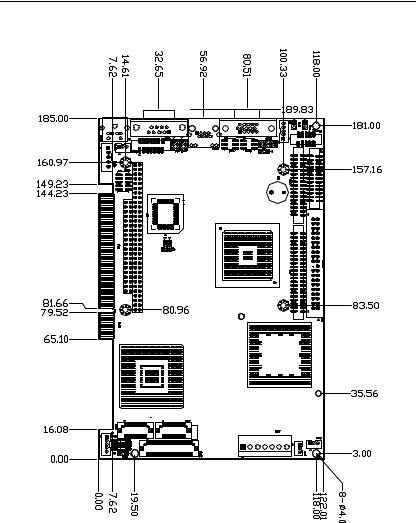
1.4 Board layout: dimensions
+
6871-PCI |
A1.REV |
I
Figure 1.1: Board layout: dimensions (component side)
5 |
Chapter 1 General Information |
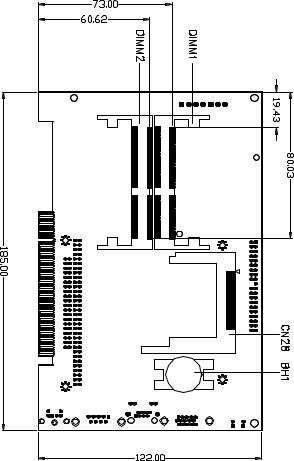
A1.REV 6871-PCI


 +
+
Figure 1.2: Board layout: dimensions (solder side)
PCI-6871 User’s Manual |
6 |

CHAPTER
2
Installation
This chapter explains the setup procedures of PCI-6871 hardware, including instructions on setting jumpers and connecting peripherals, switches and indicators. Be sure to read all safety precautions before you begin the installation procedure.
7 |
Chapter 2 Installation |

Chapter 2 Installation
2.1 Jumpers
The PCI-6871 has a number of jumpers that allow you to configure your system to suit your application. The table below lists the functions of the various jumpers.
Table 2.1: Jumpers
Label |
Function |
|
|
JP1 |
CMOS clear |
|
|
JP2 |
LAN power select |
|
|
JP3 |
RS-232/422/485 select |
|
|
JP4 |
Watch-Dog output selct |
|
|
S1 |
Panel type select |
|
|
2.2 Connectors
On-board connectors link the PCI-6871 to external devices such as hard disk drives, a keyboard, or floppy drives. The table below lists the function of each of the board’s connectors.
Table 2.2: Connectors
Label |
Function |
|
|
CN1 |
Primary IDE |
|
|
CN2 |
LPT |
|
|
CN3 |
ATX Power feature connector |
|
|
CN4 |
USB1,2 |
|
|
CN5 |
PWR_SW |
|
|
CN6 |
Floppy |
|
|
CN7 |
Secondary IDE |
|
|
CN8 |
Reset |
|
|
PCI-6871 User’s Manual |
8 |

Table 2.2: Connectors
CN9 |
IR CON |
CN10 |
Audio I/F |
|
|
CN11 |
MAIN PWR CON |
|
|
CN12 |
D-SUB VGA |
|
|
CN13 |
HDD, PWR LED CON & WDT Output |
|
|
CN14 |
DIO CON |
|
|
CN15 |
LAN RJ45 CON |
|
|
CN16 |
PC104 |
|
|
CN17 |
LCD CON2 (10*2) |
|
|
CN18 |
LCD CON1 (20*2) |
|
|
CN19 |
COM1 |
|
|
CN20 |
COM2 |
|
|
CN21 |
LVDS CON |
|
|
CN23 |
USB3,4 |
|
|
CN24 |
LCD backlight |
|
|
CN25 |
PS/2 KB/MS |
|
|
CN26 |
EXT_KB |
|
|
CN27 |
LCD INV PWR |
|
|
CN28 |
CF CON |
|
|
FAN1 |
CPU fan power |
|
|
9 |
Chapter 2 Installation |
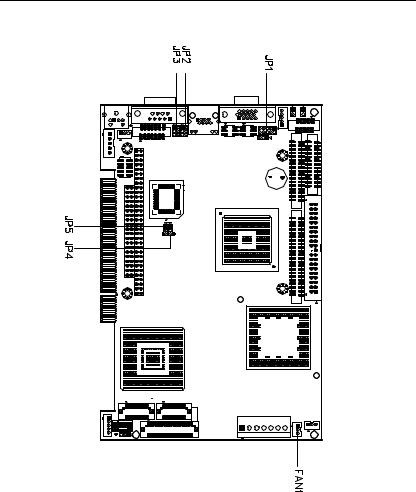
2.3 Locating jumpers
 +
+
A1.REV 6871-PCI |
I
Figure 2.1: Jumper locations
PCI-6871 User’s Manual |
10 |
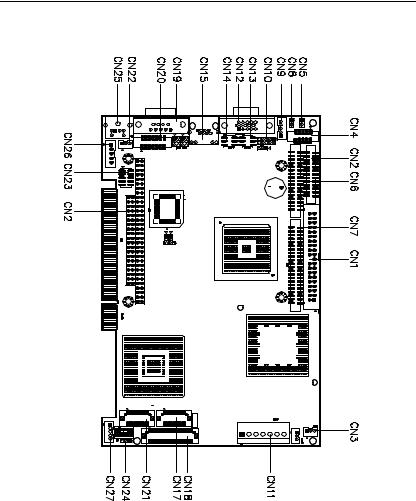
2.4 Locating Connectors
 +
+
A1.REV 6871-PCI |
I
Figure 2.2: Connectors (component side)
11 |
Chapter 2 Installation |
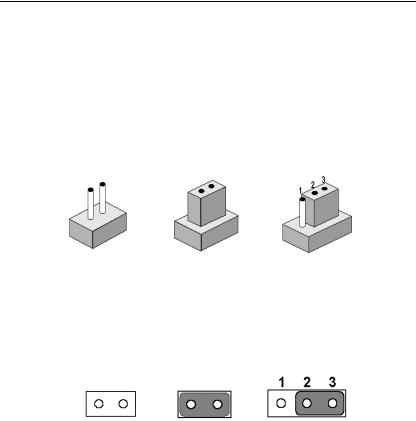
2.5 Setting Jumpers
You may configure your card to match the needs of your application by setting jumpers. A jumper is a metal bridge used to close an electric circuit. It consists of two metal pins and a small metal clip (often protected by a plastic cover) that slides over the pins to connect them. To “close” a jumper, you connect the pins with the clip. To “open” a jumper, you remove the clip. Sometimes a jumper will have three pins, labeled 1, 2 and 3. In this case you would connect either pins 1 and 2, or 2 and 3.
open |
closed |
closed 2-3 |
The jumper settings are schematically depicted in this manual as follows:.
open |
closed |
closed 2-3 |
A pair of needle-nose pliers may be helpful when working with jumpers.
If you have any doubts about the best hardware configuration for your application, contact your local distributor or sales representative before you make any changes.
Generally, you simply need a standard cable to make most connections.
PCI-6871 User’s Manual |
12 |
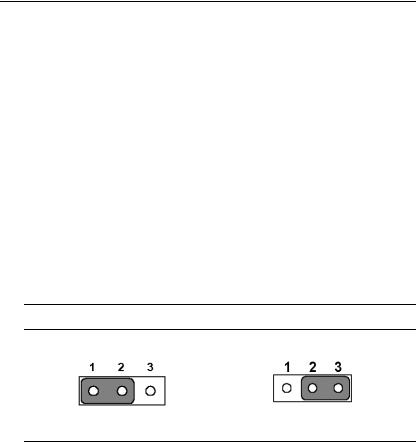
2.6 Clear CMOS (JP1)
Warning! To avoid damaging the computer, always turn off the power supply before setting “Clear CMOS.” Before turning on the power supply, set the jumper back to “3.0 V Battery On.”
This jumper is used to erase CMOS data and reset system BIOS information.
The procedure for clearing CMOS is:
1.Turn off the system.
2.Short pin 2 and pin 3.
3.Return jumper to pins 1 and 2.
4.Turn on the system. The BIOS is now reset to its default setting
Table 2.3: CMOS clear (JP1)
*3.0 V Battery on |
Clear CMOS |
|
|
* default setting
13 |
Chapter 2 Installation |

2.7 Installing system memory (SODIMMs)
You can install anywhere from 32 to 512 MB of SDRAM into your PCI-6871 Series card. The card provides two 144-pin SODIMM sockets. Each socket accepts 32/64/128/256/512 MB 3.3 V power level SODIMMs. If only one SODIMM module is installed, it may be installed in either SODIMM socket on the solder side of the PCI-6871 Series card.
Note: |
PCI-6871 Series cards only support SDRAM SODIMM |
|
modules. EDO SODIMM is not supported. |
2.7.1 Installing SODIMMs
Note: |
The modules can only fit into a socket one way. The gold |
|
pins must point down into the SODIMM socket. |
The procedure for installing SODIMMs appears below. Please follow these steps carefully.
1.Make sure that all power supplies to the system are switched off.
2.Install the SODIMM card. Install the SODIMM so that its gold pins point down into the SODIMM socket.
3.Slip the SODIMM into the socket at a 45 degree angle and carefully fit the bottom of the card against the connectors.
4.Gently push the SODIMM into a perpendicular position until the clips on the ends of the SODIMM sockets snap into place.
5.Check to ensure that the SODIMM is correctly seated and all connector contacts touch. The SODIMM should not move around in its socket.
PCI-6871 User’s Manual |
14 |
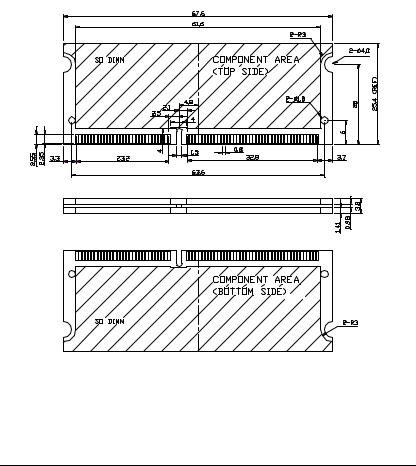
Important: Only use standard form SODIMM memory modules (as shown in the diagram below). Standardized dimensions ensure a proper fit. Check with your memory supplier about the SODIMM modules you will use.
Figure 2.3: SODIMM module
2.8 IDE, CDROM hard drive connector (CN1, CN7)
The PCI-6871 provides 2 IDE channels which you can attach up to four Enhanced Integrated Device Electronics hard disk drives or CDROM to the PCI-6871’s internal controller. The PCI-6871's IDE controller uses a PCI interface. This advanced IDE controller supports faster data transfer, PID mode 3, mode 4 and UDMA/100. The secondary channel supports UDMA/33 only.
15 |
Chapter 2 Installation |

2.8.1 Connecting the hard drive
Connecting drives is done in a daisy-chain fashion. It requires one of two cables (not included in this package), depending on the drive size. 1.8" and 2.5" drives need a 1 x 44-pin to 2 x 44-pin flat-cable connector. 3.5" drives use a 1 x 44-pin to 2 x 40-pin connector.
Wire number 1 on the cable is red or blue, and the other wires are gray.
1.Connect one end of the cable to CN1 or CN7. Make sure that the red (or blue) wire corresponds to pin 1 on the connector, which is labeled on the board (on the right side).
2.Plug the other end of the cable into the Enhanced IDE hard drive, with pin 1 on the cable corresponding to pin 1 on the hard drive. (See your hard drive’s documentation for the location of the connector.)
If desired, connect a second drive as described above.
Unlike floppy drives, IDE hard drives can connect to either end of the cable. If you install two drives, you will need to set one as the master and one as the slave by using jumpers on the drives. If you install only one drive, set it as the master.
2.9 Solid State Disk
The PCI-6871 provides a 50-pin socket for CompactFlash card type I/II.
2.9.1 CompactFlash (CN28)
The CompactFlash card shares a secondary IDE channel which can be enabled/disabled via the BIOS settings.
2.10 Floppy drive connector (CN6)
You can attach up to two floppy drives to the PCI-6871’s on-board controller. You can use any combination of 5.25” (360 KB and 1.2 MB) and/ or 3.5” (720 KB, 1.44 MB, and 2.88 MB) drives.
A 34-pin daisy-chain drive connector cable is required for a dual-drive system. On one end of the cable is a 34-pin flat-cable connector. On the other end are two sets of floppy disk drive connectors. Each set consists of a 34-pin flat-cable connector (usually used for 3.5” drives) and a printed-circuit board connector (usually used for 5.25” drives).
PCI-6871 User’s Manual |
16 |

2.10.1 Connecting the floppy drive
1.Plug the 34-pin flat-cable connector into CN6. Make sure that the red wire corresponds to pin one on the connector.
2.Attach the appropriate connector on the other end of the cable to the floppy drive(s). You can use only one connector in the set. The set on the end (after the twist in the cable) connects to the A: drive. The set in the middle connects to the B: drive.
3.If you are connecting a 5.25” floppy drive, line up the slot in the printed circuit board with the blocked-off part of the cable connec-
tor.
If you are connecting a 3.5” floppy drive, you may have trouble determining which pin is number one. Look for a number printed on the circuit board indicating pin number one. In addition, the connector on the floppy drive may have a slot. When the slot is up, pin number one should be on the right. Check the documentation that came with the drive for more information.
If you desire, connect the B: drive to the connectors in the middle of the cable as described above.
In case you need to make your own cable, you can find the pin assignments for the board’s connector in Appendix C.
2.11 Parallel port connector (CN2)
Normally, the parallel port is used to connect the card to a printer. The PCI-6871 includes a multi-mode (ECP/EPP/SPP) parallel port accessed via CN2 and a 26-pin flat-cable connector. You will need an adapter cable if you use a traditional DB-25 connector. The adapter cable has a 26-pin connector on one end, and a DB-25 connector on the other.
The parallel port is designated as LPT1, and can be disabled or changed to LPT2 or LPT3 in the system BIOS setup.
The parallel port interrupt channel is designated to be IRQ7. You can select ECP/EPP DMA channel via BIOS setup.
2.12 Keyboard and PS/2 mouse connector (CN25)
The PCI-6871 board provides a keyboard connector that supports both a keyboard and a PS/2 style mouse. In most cases, especially in embedded applications, a keyboard is not used. If the keyboard is not present, the
17 |
Chapter 2 Installation |

standard PC/AT BIOS will report an error or fail during power-on selftest (POST) after a reset. The PCI-6871’s BIOS standard setup menu allows you to select “All, But Keyboard” under the “Halt On” selection. This allows no-keyboard operation in embedded system applications, without the system halting under POST.
2.13 Power & HDD LED, Reset Button Connector
(CN13, CN8)
Next, you may want to install external switches to monitor and control the PCI-6871. These features are optional: install them only if you need them. The front panel connector (CN13) is an 8-pin male, dual in-line header. It provides connections for a speaker, hard disk access indicator, watchdog output, and an input switch for resetting the card.
2.13.1 Power & HDD LED (CN13)
The HDD LED indicator for hard disk access is an active low signal (24 mA sink rate). Power supply activity LED indicator.
2.13.2 Reset switch (CN8)
If you install a reset switch, it should be an open single pole switch. Momentarily pressing the switch will activate a reset. The switch should be rated for 10 mA, 5 V.
2.14Power connectors (CN11, FAN1)
2.14.1Main power connector, +5 V, +12 V (CN11)
Supplies main power to the PCI-6871 (+5 V), and to devices that require +12 V.
2.14.2CPU Fan power supply connector (FAN1)
Provides power supply to CPU cooling fan. Only present when +5 V and +12 V power is supplied to the board.
PCI-6871 User’s Manual |
18 |
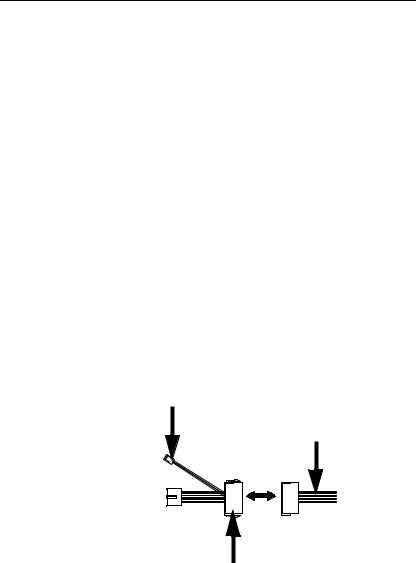
2.15ATX power control connector (CN3, CN5)
2.15.1ATX feature connector (CN3) and soft power switch connector (CN5)
The PCI-6871 can support an advanced soft power switch function, if an ATX power supply is used. To enable the soft power switch function:
1.Get the specially designed ATX-to-EBX power cable (PCI-6871 optional item, part no. 1703200100)
2.Connect the 3-pin plug of the cable to CN3 (ATX feature connector).
3.Connect the power on/off button to CN5. (A momentary type of button should be used.)
Important Make sure that the ATX power supply can take at least a 10 mA load on the 5 V standby lead (5VSB). If not, you may have difficulty powering on your system.
to CN3 ATX
features connector
ATX power supply
to main power |
connector CN11 |
20-pin female connector
Figure 2.4: Wiring for ATX soft power switch function
19 |
Chapter 2 Installation |

2.16 IR connector (CN9)
This connector supports the optional wireless infrared transmitting and receiving module. This module mounts on the system case. You must configure the setting through BIOS setup.
2.17 Audio interfaces (CN10)
The Audio link is a 10 pin connector; the PCI-6871 can support AC97 Audio with the addition of optional PCM-231A-00A1.
2.18 COM port connector (CN19, CN20)
The PCI-6871 provides two serial ports (COM1:RS-232; COM2: RS232/422/485) in one COM port connector. The COM port connector is a 40-pin, dual-inline, male header. It provides connections for serial devices (a mouse, etc.) or a communication network. You can find the pin assignments for the COM port connector in Appendix C.
2.18.1 COM2 RS-232/422/485 setting (JP3)
COM2 can be configured to operate in RS-232, RS-422, or RS-485 mode. This is done via JP3
JP3: COM2 RS-232/422/485 select
PINS |
RS-232* |
RS-422 |
RS-485 |
|
|
|
|
1-2 |
Closed |
Open |
Open |
|
|
|
|
3-4 |
Open |
Closed |
Open |
|
|
|
|
5-6 |
Open |
Open |
Closed |
|
|
|
|
2.19 VGA/LCD/LVDS interface connections
The PCI-6871’s PCI SVGA interface can drive conventional CRT displays and is capable of driving a wide range of flat panel displays, including passive LCD and active LCD displays. The board has three connectors to support these displays: one for standard CRT VGA monitors, one for flat panel displays, and one for LVDS type LCD panels.
PCI-6871 User’s Manual |
20 |
2.19.1 CRT display connector (CN12)
CN12 is a standard 15-pin D-SUB connector commonly used for VGA. The pin assignments for CRT display connector CN12 are detailed in Appendix C.
2.19.2 Flat panel display connector (CN18)
CN18 consists of a 40-pin connector which can support a 24-bit LCD panel. It is Hirose’s product no. DF13A-40DP-1.25 V
The PCI-6871 provides a bias control signal on CN18 that can be used to control the LCD bias voltage. It is recommended that the LCD bias voltage not be applied to the panel until the logic supply voltage (+5 V or +3.3 V) and panel video signals are stable. Under normal operation, the control signal (ENAVEE) is active high. When the PCI-6871’s power is applied, the control signal is low until just after the relevant flat panel signals are present. CN18 can connect up to 24 bit TFT LCD.
2.19.3 Extension flat panel connector (CN17)
CN17 consists of a 20-pin connector which is Hirose’s product no. DF13A-20DP-1.25V. The PCI-6871 supports a 36-bit LCD panel which must be connected to both the CN18 (40-pin) and the CN17 (20-pin). The pin assignments for both CN18and the CN17 can be found in Appendix C
2.19.4 LVDS LCD panel connector (CN21)
The PCI-6871 uses the VIA TwisterT chip that supports 2 channel (2 x 18 bit) LVDS LCD panel displays. Users can connect to either an 18-bit or 36-bit LVDS LCD with CN21.
21 |
Chapter 2 Installation |

2.19.5 Panel type selection (S1)
S1 is an 8 segment DIP switch for DSTN/TFT panel type and resolution functions.
Table 2.4: S1 Panel Type select
SW |
SW |
SW |
SW |
|
|
|
1-1 |
1-2 |
1-3 |
1-4 |
Panel Type & Resolution |
||
ON |
ON |
ON |
ON |
TFT |
640x480** |
18bit (H. V. Freq) |
|
|
|
|
|
|
|
ON |
ON |
ON |
OFF |
TFT |
648x480 |
18bit (Synthetic) |
|
|
|
|
|
|
|
ON |
ON |
OFF |
ON |
TFT |
648x480** |
N/A |
|
|
|
|
|
|
|
ON |
ON |
OFF |
OFF |
TFT |
648x480** |
LVDS |
|
|
|
|
|
|
|
ON |
OFF |
ON |
ON |
DSTN |
648x480** |
18bit |
|
|
|
|
|
|
|
ON |
OFF |
ON |
OFF |
TFT |
800x600** |
18bit (H. V. Freq) |
|
|
|
|
|
|
|
ON |
OFF |
OFF |
ON |
TFT |
800x600* |
18bit (Synthetic) |
|
|
|
|
|
|
|
ON |
OFF |
OFF |
OFF |
TFT |
800x600 |
LVDS |
|
|
|
|
|
|
|
OFF |
ON |
ON |
ON |
TFT |
800x600** |
N/A |
|
|
|
|
|
|
|
OFF |
ON |
ON |
OFF |
DSTN |
800x600** |
18bit |
|
|
|
|
|
|
|
OFF |
ON |
OFF |
ON |
TFT |
1024x768** |
36bit (H. V. Freq) |
|
|
|
|
|
|
|
OFF |
ON |
OFF |
OFF |
TFT |
1024x768 |
36bit (Synthetic) |
|
|
|
|
|
|
|
OFF |
OFF |
ON |
ON |
TFT |
1024x768** |
LVDS |
|
|
|
|
|
|
|
OFF |
OFF |
ON |
OFF |
TFT |
1024x768** |
N/A |
|
|
|
|
|
|
|
OFF |
OFF |
OFF |
ON |
DSTN |
1024x768** |
18bit |
|
|
|
|
|
|
|
OFF |
OFF |
OFF |
OFF |
DSTN |
1024x768** |
24bit |
* Default setting
**will support in the future
2.20Ethernet configuration
The PCI-6871 is equipped with a high performance 32-bit PCI-bus Ethernet interface which is fully compliant with IEEE 802.3U 10/100Mbps CSMA/CD standards. It is supported by all major network operating systems.
The medium type can be configured via the RSET8139.EXE program included on the utility disk. (See Chapter 3 for detailed information.)
PCI-6871 User’s Manual |
22 |
